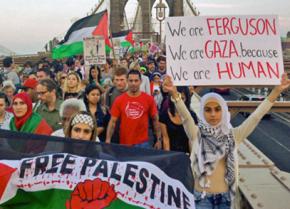Documenting the campus struggle for Palestine
reviews a book that chronicles the campus movement against apartheid.
NORA BARROWS-Friedman's In Our Power: U.S. Students Organize for Justice in Palestine is a masterpiece of social movement journalism.
In the tradition of Howard Zinn's SNCC: The New Abolitionists and Staughton and Alice Lynd's Rank and File, Barrows-Friedman presents a riveting "from below" oral history of a grassroots campaign for social justice.
In Barrows-Friedman's case, the historical actors are students in the Students for Justice in Palestine (SJP) movement that, since the start of the Boycott, Divest, Sanctions (BDS) movement against Israel in 2005, has become the vanguard in a global fight against Israeli apartheid. Her dynamic book might as well be subtitled "10 years that shook the world."
Barrows-Friedman is a staff editor and reporter for Electronic Intifada. Between 2004 and 2011, she traveled regularly to Palestine as a reporter for Pacifica Network radio. As she explains in her preface, it was the rising tide of student solidarity organizing against Israeli apartheid that compelled her to write a book in which "Palestinian-American students speak for themselves about their experiences as organizers and human rights defenders."

From April 2013 to January 2014, Barrows-Friedman crisscrossed the U.S, conducting 63 interviews with student representatives from 30 different Universities and private colleges in 22 cities across 11 states. The resulting book juxtaposes transcripted interviews with SJP activists with political reportage of key episodes from what Barrows-Friedman calls the campus "battleground" over Israel.
These include successful divestment votes at University of California campuses; walkouts by students at the University of Kentucky in protest of a speech by then-Israeli Prime Minister Ehud Olmert; students battles with pro-Zionist Anti-Defamation League forces at Harvard; and the formation in 2010 of the National Students for Justice network at a Columbia University conference.
THE STUDENT interviews give a composite portrait of what has been called "Generation Palestine." These are activists who have grown to political consciousness in a post-9/11, post-Intifada age of intertwined Islamophobia and U.S. imperialism, one of whose cornerstones is support for Israel's occupation.
DePaul University SJP activist Shirien Darma says her activist turn began by seeing television images of the Second Intifada; UCLA SJP activist Rahim Kurwa recalls connecting his campus organizing work around fair trade to a course in Middle East history where a professor opened up discussion of Israel and Palestine; Stanford student Kristian Davis Bailey says he was radicalized into Palestinian activism while researching a story for the school newspaper about Stanford alumnus Fadi Quran, who was arrested and pepper-sprayed during a West Bank protest; UC Berkeley SJP activist Yaman Salahi recalls Operation Cast Lead, Israel's murderous late 2008 invasion of Gaza resulting in more than 1,500 deaths, as a critical moment in jumpstarting campus activism.
The achievement and resilience of SJP students in the face of often brutal repression from both campus administrations and Zionist forces on and off campus provides a dramatic baseline to Barrow-Friedman's story. Students from SJP chapters at Northeastern University, Florida Atlantic University, Harvard and San Diego State University recount personal, physical and administrative challenges to their activism, including threats of expulsion, arrest and physical attack.
Arguably, the University of California system, where seven of 10 campuses have now voted to divest, has seen the sharpest of these struggles.
In 2011, for example, Zionist students filed a lawsuit against the University of California-Berkeley saying the campus had failed to protect Jewish students from a "hostile atmosphere" created by Palestinian activists.
In the same year, 10 University of California Irvine students were convicted of the misdemeanor crime of "disrupting a public meeting" after a non-violent protest against the 2010 appearance on campus of Israel ambassador to the U.S. Michael Oren. The students challenged Oren's justification of the massacre of 1,500 Palestinians during Operation Cast Lead, calmly stating from their floor positions things like, "You, sir, are an accomplice to genocide."
In an important chapter titled "Intersecting Struggles and Common Causes," Barrows-Friedman shows how SJP organizers have teamed up with immigrant rights activists in Arizona, LGBT activists to protest Israeli "pinkwashing," and anti-racist activists radicalized by protests against police shootings and the Trayvon Martin killing. Her book shows the seedlings of what became the Ferguson to Gaza protests after Mike Brown's killing in the summer of 2014. B
arrows-Friedman also shows how activists like Shafedka Hashash at New York University have tied BDS activism both to workers' rights and disability rights struggles on campus. This brand of activism culminated in the important December, 2014, divestment vote by United Auto Workers Local 2865, representing more than 10,000 University of California graduate student employees.
Barrows-Friedman's book is both a living chronicle and a handbook of one of the most explosive civil rights movements of our times. Since its publication just a few short months ago, new divestment resolutions have passed at college campuses in London, Ontario, Canada and across the U.S. As I write this review, student activists at Loyola University in Chicago are celebrating passage of their own divestment resolution.
SJP and Palestinian solidarity activists everywhere should buy and read this book, then write the next chapter for themselves.


